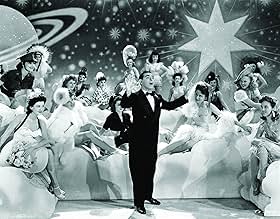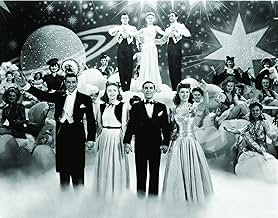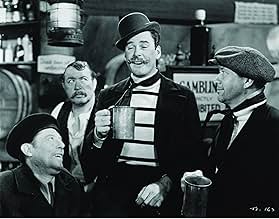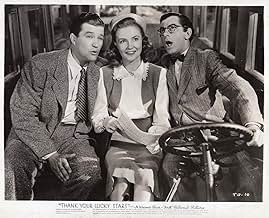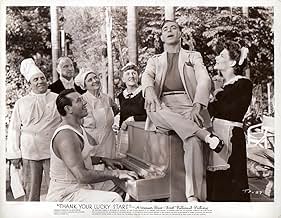ÉVALUATION IMDb
6,7/10
2,2 k
MA NOTE
Ajouter une intrigue dans votre langueTwo producers are putting together a wartime charity show with an all-star cast, but the egotism of radio personality Eddie Cantor disrupts their plans.Two producers are putting together a wartime charity show with an all-star cast, but the egotism of radio personality Eddie Cantor disrupts their plans.Two producers are putting together a wartime charity show with an all-star cast, but the egotism of radio personality Eddie Cantor disrupts their plans.
- Nommé pour 1 oscar
- 1 nomination au total
S.Z. Sakall
- Dr. Schlenna
- (as S.K. Sakall)
Histoire
Le saviez-vous
- AnecdotesWhen Conrad Wiedell takes Bette Davis and does the jitterbug, she felt he was holding back in rehearsals and told him to treat her like an experienced dance partner. When the cameras rolled, Wiedell--a national jitterbug champion hired specifically for this dance--pulled out all the stops and swung her around and she fell on her knee. As she finishes her song, she is seen limping out of the nightclub set and leaning against a post, rubbing her knee. This was a real injury, but she finished the song despite the pain. When director David Butler asked Davis to "try it once more," she replied, "No! No! I said one take, and that was it." She then turned to the press who had shown up to watch her number, telling them "Show's over, gentlemen. Now get the hell out."
- GaffesIn one of the scenes, Eddie Cantor dressed as an American Indian, is being chased by other men dressed as American Indians, the film negative has been flipped; the signs on store windows are backward/mirror images.
- Citations
Humphrey Bogart: [after an effort at being tough has no effect whatsoever on S.K. Sakall] Hey, I must be losing my touch! I hope my movie fans don't hear about this!
- Générique farfeluAt the end, the words "THE END" are sewn into the curtains.
- ConnexionsFeatured in Arena: Bette Davis: A Basically Benevolent Volcano (1983)
- Bandes originalesThank Your Lucky Stars
(1943) (uncredited)
Music by Arthur Schwartz
Lyrics by Frank Loesser
Performed by Dinah Shore on a radio show
Reprised by a chorus at the end
Commentaire en vedette
See all of your favorite 1940s Warner Bros. stars as you've never seen them before!
This star-studded WWII morale-booster is not unlike similar star-studded WWII morale-boosters put out by other studios, featuring the big names in brief cameos sprinkled throughout a thin "let's put on a benefit" plot. Here the WB stars perform little vaudeville sketches, singing and dancing, as part of a charity show. And we're talking some big names here: Bette Davis, Errol Flynn, Olivia de Havilland, John Garfield, Ida Lupino, Ann Sheridan, Jack Carson, etc.
The real star, however, is Eddie Cantor. Much of the movie is about how annoying and overbearing Cantor is, with Cantor in a dual role as both a parody of himself and his resentful look-alike. In an exhibit of good-humored self-deprecation, Cantor allows his name to be dragged through the mud by critics of his corny jokes and swollen ego (his alternate character among them). As one character or the other Cantor moves the screwy plot along.
This movie is simply a star-studded, feel-good musical. And it is a lot of fun. The stars who really shine in this are John Garfield, Bette Davis, and Cantor. Dinah Shore is featured prominently in her first screen appearance and we even get to see Spike Jones and His City Slickers in action. Errol Flynn has a nice number and Alexis Smith shows off her dancing background. S.Z. Sakall is hilarious as always and the young romantic couple (Joan Leslie and Dennis Morgan) make sure to plug recent WB successes. (Leslie lets go with impressions of Lupino and James Cagney.)
It's interesting, in the scene where Olivia de Havilland and Ida Lupino dance on either side of George Tobias (in a slightly awkward jive routine), to note the contrast in the actresses' performances. Both de Havilland and Lupino are in the frame, basically playing clones of each other. But it seems like de Havilland just put so much more into her performance, particularly with her facial expressions.
It's a treat to see all of these stars in one movie and it's a treat to see them do something fun and different. The songs won't always blow you away, but they're pleasant enough. The finale is a medley of all the songs we've heard, with the welcome return of the stars we've seen. It's a fitting cap to the viewer's journey, and should leave everyone in a good mood. I think I liked the music more after hearing it all reprised in the finale.
Top-billed Humphrey Bogart has about a minute of screen time and, though he leaves an impression, he doesn't do any singing or dancing.
This star-studded WWII morale-booster is not unlike similar star-studded WWII morale-boosters put out by other studios, featuring the big names in brief cameos sprinkled throughout a thin "let's put on a benefit" plot. Here the WB stars perform little vaudeville sketches, singing and dancing, as part of a charity show. And we're talking some big names here: Bette Davis, Errol Flynn, Olivia de Havilland, John Garfield, Ida Lupino, Ann Sheridan, Jack Carson, etc.
The real star, however, is Eddie Cantor. Much of the movie is about how annoying and overbearing Cantor is, with Cantor in a dual role as both a parody of himself and his resentful look-alike. In an exhibit of good-humored self-deprecation, Cantor allows his name to be dragged through the mud by critics of his corny jokes and swollen ego (his alternate character among them). As one character or the other Cantor moves the screwy plot along.
This movie is simply a star-studded, feel-good musical. And it is a lot of fun. The stars who really shine in this are John Garfield, Bette Davis, and Cantor. Dinah Shore is featured prominently in her first screen appearance and we even get to see Spike Jones and His City Slickers in action. Errol Flynn has a nice number and Alexis Smith shows off her dancing background. S.Z. Sakall is hilarious as always and the young romantic couple (Joan Leslie and Dennis Morgan) make sure to plug recent WB successes. (Leslie lets go with impressions of Lupino and James Cagney.)
It's interesting, in the scene where Olivia de Havilland and Ida Lupino dance on either side of George Tobias (in a slightly awkward jive routine), to note the contrast in the actresses' performances. Both de Havilland and Lupino are in the frame, basically playing clones of each other. But it seems like de Havilland just put so much more into her performance, particularly with her facial expressions.
It's a treat to see all of these stars in one movie and it's a treat to see them do something fun and different. The songs won't always blow you away, but they're pleasant enough. The finale is a medley of all the songs we've heard, with the welcome return of the stars we've seen. It's a fitting cap to the viewer's journey, and should leave everyone in a good mood. I think I liked the music more after hearing it all reprised in the finale.
Top-billed Humphrey Bogart has about a minute of screen time and, though he leaves an impression, he doesn't do any singing or dancing.
- jimjo1216
- 14 sept. 2011
- Lien permanent
Meilleurs choix
Connectez-vous pour évaluer et surveiller les recommandations personnalisées
- How long is Thank Your Lucky Stars?Propulsé par Alexa
Détails
- Date de sortie
- Pays d’origine
- Langue
- Aussi connu sous le nom de
- Adorables estrellas
- Lieux de tournage
- Beverly Hills, Californie, États-Unis(tour of stars' homes)
- société de production
- Consultez plus de crédits d'entreprise sur IMDbPro
Box-office
- Budget
- 1 568 000 $ US (estimation)
- Durée2 heures 7 minutes
- Couleur
- Rapport de forme
- 1.37 : 1
Contribuer à cette page
Suggérer une modification ou ajouter du contenu manquant

Lacune principale
By what name was Thank Your Lucky Stars (1943) officially released in India in English?
Répondre
